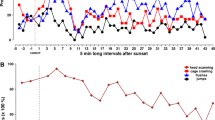Abstract
We tested the hypothesis that magnetic alignment, a tendency to align the body axis with a certain angle to the field lines of the geomagnetic field, provides direction indicator (the so-called nonsense orientation) also in mammals. We measured alignment of free-ranging (grazing or standing) roe deer and the compass direction of their escape trajectories as well as the direction from the threat and to the next shelter. Roe deer were significantly nonrandomly aligned along the north-south axis when grazing. In 188 provocations performed in open flat habitats, deer also tended to escape along this axis and avoided to escape westwards or eastwards. Thus, in many provocations (those from east or west), animals fled at wide angles, either northwards or southwards and not straight away from the threat, a strategy that would maximize the distance between the animal and the danger. Since all the factors which might influence direction of escape (sun position, wind direction, direction to the shelter, straight direction from danger) were randomly distributed in time and space, they constitute just statistical noise which does not add. The only common denominator of all data sets was the magnetic field. We conclude that the north-south alignment expresses the readiness to escape along this axis and might help to synchronize the movement and cohesion of the group and also supports mental mapping of space.
Significance statement
This is the first study of escape behavior in animals which considers also the role of absolute compass direction. Our findings confirm existence of magnetic alignment and thus magnetosensitivity in the roe deer and provide first evidence for its role as the so-called direction indicator in control of escape behavior in roe deer in particular and in mammals in general. Our results make the speculations more plausible that the magnetic alignment helps to organize and read the mental (cognitive) map of space. (In analogy, humans are more efficient in reading and commenting the map, if it is held in an accustomed direction: with north pointing upwards and if the person aligns with the map and with the visible landmarks.)








Similar content being viewed by others
References
Batschelet E (1981) Circular statistics in biology. Academic Press, London
Begall H, Burda H, Malkemper EP (2014) Magnetoreception in mammals. Adv Stud Behav 46:45–88
Begall S, Červený J, Neef J, Vojtěch O, Burda H (2008) Magnetic alignment in grazing and resting cattle and deer. Proc Natl Acad Sci U S A 105:13451–13455
Begall S, Malkemper EP, Červený J, Němec P, Burda H (2013) Magnetic alignment in mammals and other animals. Mammal Biol 78:10–20
Burda H, Begall S, Červený J, Neef J, Němec P (2009) Extremely low-frequency electromagnetic fields disrupt magnetic alignment of ruminants. Proc Natl Acad Sci U S A 106:5708–5713
Cooper WF Jr, Blumstein DT (2015) Escaping from predators: an integrative view of escape decisions. Cambridge University Press, Cambridge
xde Boer HY, van Breukelen L, Hootsmans MJM, van Wieren SE (2004) Flight distance in roe deer Capreolus capreolus and fallow deer Dama dama as related to hunting and other factors. Wildlife Biol 10:35–41
Domenici P, Blagburn JM, Bacon JP (2011a) Animal escapology I: theoretical issues and emerging trends in escape trajectories. J Exp Biol 214:2463–2473
Domenici P, Blagburn JM, Bacon JP (2011b) Animal escapology II: escape trajectory case studies. J Exp Biol 214:2474–2494
Goodenough AE, Maitland DP, Hart AG, Elliot SL (2008) Nestbox orientation: a species-specific influence on occupation and breeding success in woodland passerines: capsule nestbox orientation has species-specific influences on nestbox occupation and breeding success for woodland passerines. Bird Study 55:222–232
Hart V, Kušta T, Němec P et al (2012) Magnetic alignment in carps: evidence from the Czech Christmas fish market. PLoS ONE 7:e51100
Hart V, Malkemper EP, Kušta T et al (2013a) Directional compass preference for landing in water birds. Front Zool 10:38
Hart V, Nováková P, Malkemper EP et al (2013b) Dogs are sensitive to small variations of the Earth’s magnetic field. Front Zool 10:80
Immelmann K, Beer C (1992) A dictionary of ethology. Harvard University Press, Boston
Matthews GVT (1961) Nonsense orientation in Mallard Anas platyrhynchos, and its relation to experiments on bird navigation. Ibis 103:211–230
Møller AP (1992) Nest boxes and scientific rigour of experimental studies. Oikos 63:309–311
Stankowich T (2008) Ungulate flight responses to human disturbance: a review and meta-analysis. Biol Conserv 141:2159–2173
Stankowich T, Coss RG (2007) Effects of risk assessment, predator behavior, and habitat on escape behavior in Columbian black-tailed deer. Behav Ecol 18:358–367
Thake MA (1981) Nonsense orientation: an adaptation for flocking during predation? Ibis 123:47–248
Acknowledgments
This research was supported by the Grant Agency of the Czech Rep. (project no. 15-21840S) and by the Internal Grant Agency of Faculty of Forestry and Wood Sciences (IGA FLD, reg. no. B0114/006). We thank Zdeněk Trojan for assistance in the field. We highly appreciate constructive comments and suggestions by the reviewers.
Author information
Authors and Affiliations
Corresponding author
Ethics declarations
Ethics statement
The study was performed in the framework of regular patrolling of the gamekeepers through the hunting grounds, and the study did not involve any disturbance of the animals beyond this regular activity.
Additional information
Communicated by W. Wiltschko
Rights and permissions
About this article
Cite this article
Obleser, P., Hart, V., Malkemper, E.P. et al. Compass-controlled escape behavior in roe deer. Behav Ecol Sociobiol 70, 1345–1355 (2016). https://doi.org/10.1007/s00265-016-2142-y
Received:
Revised:
Accepted:
Published:
Issue Date:
DOI: https://doi.org/10.1007/s00265-016-2142-y




